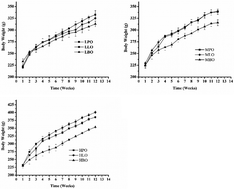Benefits of blended oil consumption over other sources of lipids on the cardiovascular system in obese rats
Abstract
High consumption of cooking oils in modern society is believed to be the major cause of cardiovascular disease. The effect of cooking oils depends on their fatty acid composition. Therefore, it is important to blend different types of oils to improve functional properties. In this study we evaluated the effects of a functional blended oil (BO) composed of a high level of oleic acid (OA) (50.93%) and α-linolenic acid (ALA) (5.41%) on cardiovascular health, blood pressure (BP) and body weight (BW) in comparison with lard oil (LO) and peanut oil (PO). Ninety male Wistar rats were divided into three groups and fed for 12 weeks with BO, LO and PO. Each group was divided into low, middle and high fat groups and fed with oil supply ratios of 6.7%, 10.9% and 48.1%, respectively. After the feeding period, the rats were sacrificed, and data were collected and analyzed. Rats treated with BO especially at a high dose (HBO) showed a significantly lower body weight, fat weight, liver weight, fat ratio, food intake and energy intake. BO significantly reduced n-6/n-3 levels in plasma, liver and adipose tissues as well as serum triglycerides (TGs) and low density lipoprotein cholesterol (LDL-C) but contrarily increased high density lipoprotein cholesterol (HDL-C). Furthermore, HBO treatments decreased mRNA expression of lipid anabolism-related genes, lipid inflammatory-related genes, toll-like receptor 4 (TLR4), nuclear factor kappa beta (NF-κB) and monocyte chemoattractant protein (MCP)-1 and increased lipid catabolism-related genes as well as peroxisome proliferator-activated receptor gamma mRNA (PPARγ mRNA). In terms of antioxidant enzymes, BO treatment has increased the activity of catalase (CAT), glutathione peroxidase (GPx) and superoxide dismutase (SOD) by lowering malondialdehyde (MDA) and reactive oxygen species (ROS) in tissues. Moreover, BO supplementation showed a significant lowering effect on the serum levels of C-reactive protein (CRP) and tumor necrosis factor alpha (TNF-α), blood pressure (BP), atherosclerosis index (AI) and heart rate (HR). These findings highlight that the new blend of canola oil, corn oil, olive oil, peanut oil and sunflower oil with a low n-6/n-3 PUFA ratio of 6 : 1 could prevent and control cardiovascular disease (CVD).



 Please wait while we load your content...
Please wait while we load your content...